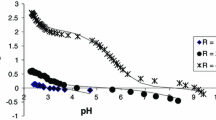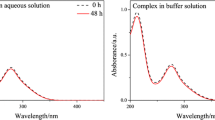Abstract
Binary and ternary complexes of copper(II) involving N,N,N′,N′-tetramethylethylene-diamine (Me4en) and various biologically relevant ligands containing different functional groups are investigated. The ligands (L) used are dicarboxylic acids, amino acids, peptides and DNA unit constituents. The ternary complexes of amino acids, dicarboxylic acids or peptides are formed by simultaneous reactions. The results showed the formation of Cu(Me4en)(L) complexes with amino acids and dicarboxylic acids. The effect of chelate ring size of the dicarboxylic acid complexes on their stability constants was examined. Peptides form both Cu(Me4en)(L) complexes and the corresponding deprotonated amide species Cu(Me4en)(LH−1). The ternary complexes of copper(II) with (Me4en) and DNA are formed in a stepwise process, whereby binding of copper(II) to (Me4en) is followed by ligation of the DNA components. DNA constituents form both 1:1 and 1:2 complexes with Cu(Me4en)2+. The concentration distribution of the complexes in solution was evaluated. [Cu(Me4en)(CBDCA)] and [Cu(Me4en)(malonate)] are isolated and characterized by elemental analysis and infrared measurements.
Similar content being viewed by others
References
Sigmon, D.S., Mazumder, A., Perrin, D.M.: Scission of DNA with Bis(1,10Phenanthroline) Copper without intramolecular hydrogen migration. Chem. Rev. a3, 2295–2316 (1993)
Burger, K.: Biocoordination Chemistry: Coordination Equilibria in Biologically-Active Systems, Ellis Harwood, Chichester (1990)
Martin, R.B., Sigel, H.: Metal Ions in Biological Systems. Marcel Dekker, New York, vol. 9, p. 1 (1979)
Paavassiliou, A.G.: Chemical nucleases as probes for studying DNA protein interactions. J. Biochem. 305, 345–357 (1995)
Sabat, M., Liert, B.: Metal Ions in Biological Systems, In: H. Sigel (ed.) Marcel Dekker, p. 33 (1996)
Shehata, M.R., Shoukry, M.M., Barakat, M.H.: Coordination Properties of 6-aminopencillanic acid: binary and ternary complexes involving biorelevant ligands. J. Coord. Chem. 57(16), 1369–1386 (2004)
Bubarcic, Z.D., Jancic, D.M., Shoukry, A.A., Shoukry, M.M.: Rate and equilibrium data for substitution reactions of [Pd(dien)Cl]+ with L-cystein and glutathione in aqueous solution. Monatshefte für Chemie 135, 151–??? (2004)
Elsherif, A.A., Shoukry, M.M., van Eldik, R.: Complex-formation reactions and stability constants for mixed-ligand complexes of diaqua(2-picolylamine)palladium(ii) with some bio-relevant ligands. J. Chem. Soc., Dalton Trans. 1425–1432 (2003)
Mohamed, M.M., Shoukry, M.M.: Complex-formation reactions of (n,n′-dimethylethylenediamine)- palladium(ii) with various biologically relevant ligands. Polyhedron 20, 343–352 (2001)
Shoukry, M.M., Khairy, E.M., Elsherif, A.A.: Ternary complexes involving Copper(II) and amino acids, peptides and DNA constituents. the kinetics of hydrolysis of α-amino acid esters. J. Trans. Metal Chem. 27, 656–664 (2002)
Mohamed, M.M., Shoukry, M.M.: Complex-formation equilibria of palladium(ii) complexes involving N,N′-dimethylethylenediamine DNA constituents and cyclobutane dicarboxylic acid. The catalysis of glycine ethyl ester hydrolysis through complex formation. Polyhedron 21, 167–173 (2002)
Shoukry, A., Rau, T., Shoukry, M., van Eldik, R.: Kinetics and mechanisms of the ligand substitution reactions of bis(amine) (cyclobutane-1,1-dicarboxylato)palladium(II). J. Chem. Soc., Dalton Trans. 3105–3112 (1998)
Rau, T., Shoukry, M., van Eldik, R.: Complex formation and ligand substitution reactions of (2-picolylamine)palladium(ii) with various biologically relevant ligands. Characterization of (2-Picolylamine) (1,1-Cyclobutanedicarboxylato)palladium(II). Inorg. Chem. 36, 1454–1463 (1997)
Vogel: Text book of Quantitative Chemical analysis. 5th Edition, Chapter 10, p. 326, Longman, UK (1989)
Vogel: Text book of Quantitative Chemical analysis. 5th Edition, Chapter 15, p. 555, Longman, UK (1989)
Stark, J.G., Wallace, H.G. (Eds.): Chemistry Data Book. murray, London, 75 (1975)
Gans, P., Sabatini, A., Vacca, A.: An improved computer program for the computation of formation constants from potentiometric data. Inorg. Chim. Acta 18, 237–239 (1976)
Pettit, L.: University of Leeds, personal communication.
Shoukry, A.: Complex formation reactions of (2,2′-dipyridylamine) copper(II) with various biologically relevant ligands. The kinetics of hydrolysis of amino acid esters. Transition Metal Chem. 30, 814–827 (2005)
Siegel, H., Martin, R.B.: Coordination properties of the amide bond stability and structure of metal ion complexes of peptides and related ligands. Chem. Rev. 82, 385–426 (1982)
Grenouillet, P., Martin, R.P., Rossi, A., Ptak, M.: Interactions between copper(II) ions L-threoinine, L-allo-threonine and L-serine in aqueous solutions. Biochim. Biophys. Acta 322, 185–??? (1973)
Savago, I., Kiss, A., Farkas, E., Sanna, D., Marras, P., Micerain, G.: Potentiometric and spectroscopic studies on the ternary complexes of copper(II) with dieptides and nucleobases. J. Inorg. Biochem. 65, 103–108 (1997)
Daniele, P.G., Zerbinati, O., Zelano, V., Ostacoli, G.: Thermodynamics and spectroscoic study of copper(II)-glylcyl-L-histidylglycine complexes in aqueous solution. J. Chem. Soc., Dalton Trans. 10, 2711–2715 (1991)
Siegel, H.: Ternary Cu+ complexes stability, structure, and reactivity. Angew. Chem. Int-Edn. 14, 394–402 (1975)
Snell, F.D., Hilton, C.L.: Encyclopedia of Industrial Chemical Analysis. New York: Interscience, 4, p. 74 (1967)
Nakamoto, N.: Infrared and raman spectra of inorganic and coordination compounds, 4th Edition Whiley & Sons New York, 228, 229, 237–239 (1986)
Cotton, F.A., Wilkinson, G.: Basic Inorganic Chemistry. Wiley & Sons, New York, Part 3, pp. 353–379 (1973)
Shoukry, M.M., Saeed, A., Khairy, E.M.: Equilibrium and hydrolysis of α-amino acid esters in ternary complexes of copper(II) involving glycyl-L-tyrosine. Trans. Metal Chem. 14, 347–350 (1989)
Siegel, H., Massoud, S.S., Corfu, N.A.: Comparison of the extent of base backbinding in complexes of divalent metal ions with guanine (GMP2-), inosine(IMP2-) and adenosine 5-Monophosphate (AMP2-). The crucial role of N-7 basicity in metal ion- nucleic base recognition. J. Am. Chem. Soc. 116, 2958–2971 (1994)
Author information
Authors and Affiliations
Corresponding author
Rights and permissions
About this article
Cite this article
Shoukry, A.A., Mohamed, M.M.A. & Shoukry, M.M. Binary and Ternary Complexes of Copper(II) Involving N,N,N′,N′-Tetramethylethylenediamine (Me4en) and Various Biologically Relevant Ligands. J Solution Chem 35, 853–868 (2006). https://doi.org/10.1007/s10953-006-9032-2
Received:
Accepted:
Published:
Issue Date:
DOI: https://doi.org/10.1007/s10953-006-9032-2




